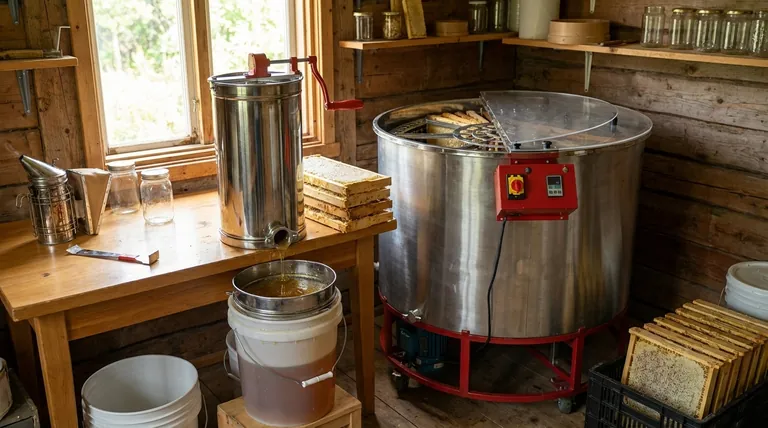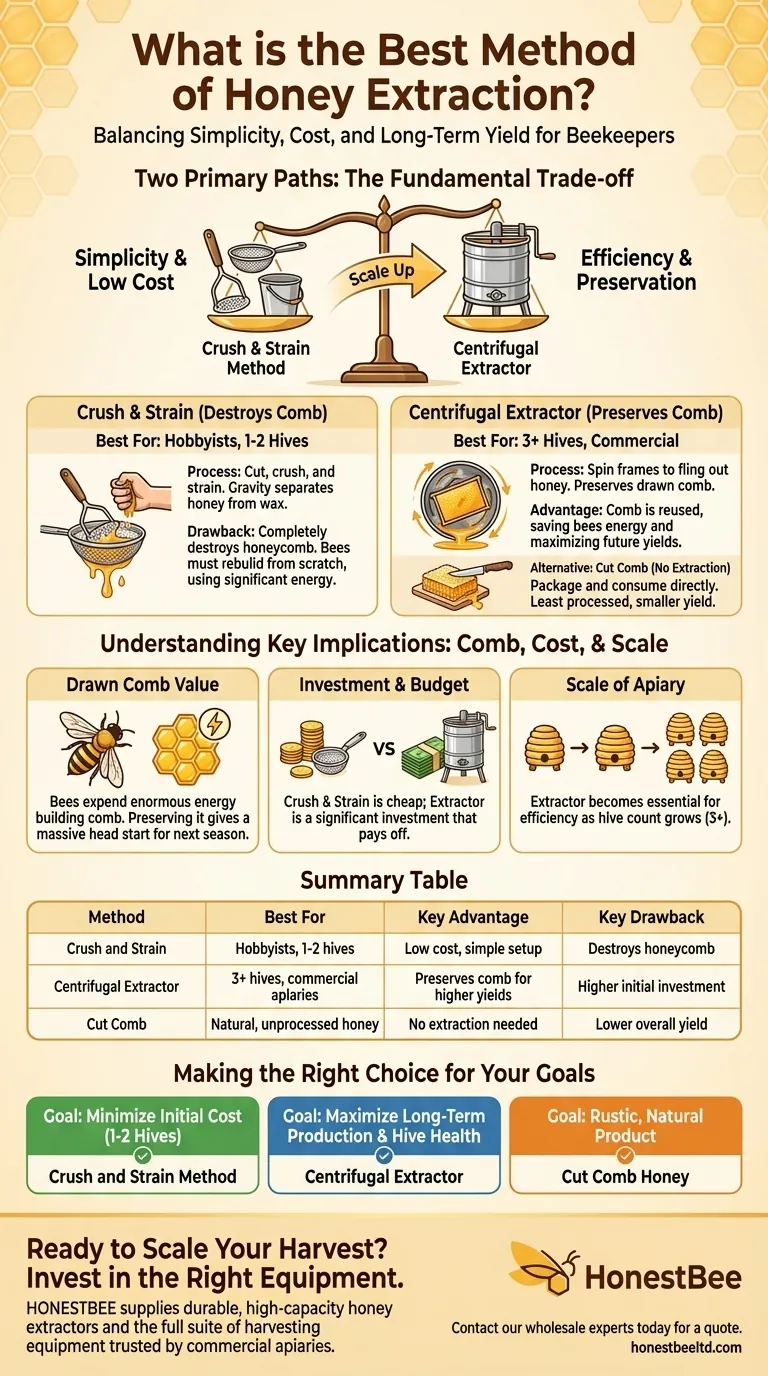The best method of honey extraction depends entirely on your scale, budget, and long-term goals as a beekeeper. For small-scale hobbyists, the crush and strain method is simple and inexpensive. For beekeepers with multiple hives who want to maximize future yields, a manual or electric centrifugal extractor is the superior choice because it preserves the delicate honeycomb for the bees to reuse.
The core decision in honey extraction is not about finding one "best" method, but understanding a fundamental trade-off: simplicity and low cost versus efficiency and the preservation of your bees' hard work.

Two Primary Paths: Extraction vs. Crushing
At its heart, honey harvesting follows one of two philosophies. You either remove the honey while preserving the comb structure, or you sacrifice the comb to get the honey.
The Centrifugal Extractor: Preserving the Comb
A centrifugal extractor is a drum that spins frames of honeycomb at high speed. After the wax cappings are sliced off the comb with a hot knife, centrifugal force flings the honey out of the cells and onto the walls of the drum, where it drips down to be collected.
This is the standard for most serious beekeepers because it preserves the drawn comb. Bees can immediately begin refilling the intact cells, saving them an immense amount of energy and resources they would otherwise spend rebuilding wax. Extractors can be manual (hand-cranked) or motorized.
The Crush and Strain Method: Simplicity and Low Cost
This is the most basic and ancient method. The entire honeycomb is cut from the frame, crushed using a tool like a potato masher, and placed in a sieve or cheesecloth over a bucket. Gravity does the work, allowing the honey to slowly drip through while the wax is left behind.
This method requires minimal specialized equipment and is very straightforward. However, its major drawback is that it completely destroys the honeycomb, forcing the bees to start from scratch on the next honey flow.
What About Cut Comb?
A third option is to simply package and consume the honey directly in its comb. This "cut comb" method involves no extraction at all. You simply cut a clean section of capped honeycomb and package it. It’s the least processed form of honey but yields a smaller amount than a full extraction.
Understanding the Trade-offs: Comb, Cost, and Scale
Your choice of method has significant implications for your apiary's productivity and your wallet.
The Critical Value of Drawn Comb
Bees expend enormous energy to produce wax and construct the intricate hexagonal cells of a honeycomb. By preserving this "drawn comb" with an extractor, you give your colony a massive head start for the next season. They can focus on foraging and making honey rather than rebuilding their pantry.
Destroying the comb via the crush and strain method sets the bees back significantly, which will almost always result in a smaller honey harvest the following year.
Investment: Equipment and Budget
The crush and strain method is exceptionally cheap. You likely already own most of what you need: food-grade buckets, a kitchen strainer, and a knife.
A centrifugal extractor, even a small manual one, is a significant investment. You will also need an uncapping knife, a tank or bucket to catch the wax cappings, and filters. This equipment is a long-term asset that pays for itself through increased hive productivity.
Scale: From One Hive to an Apiary
For a beekeeper with one or two hives, the crush and strain method is a perfectly viable and practical starting point. The loss of comb is manageable on a small scale.
Once you expand to three or more hives, the efficiency gains and comb preservation offered by an extractor become almost essential. Crushing and straining honey from several hives is incredibly time-consuming, and the cumulative loss of comb will noticeably impact your total honey yield.
Making the Right Choice for Your Apiary
To select the best method, you must first define your primary goal.
- If your primary focus is minimizing initial cost and effort for 1-2 hives: The crush and strain method is your most practical starting point.
- If your primary focus is maximizing long-term honey production and hive health: Investing in a centrifugal extractor to preserve your comb is the superior strategy.
- If your primary focus is a rustic, natural product with minimal processing: Selling or consuming cut comb honey is an excellent and simple alternative.
By aligning your extraction method with your specific goals, you ensure a successful and rewarding harvest from your hives.
Summary Table:
| Method | Best For | Key Advantage | Key Drawback |
|---|---|---|---|
| Crush and Strain | Hobbyists, 1-2 hives | Low cost, simple setup | Destroys honeycomb |
| Centrifugal Extractor | 3+ hives, commercial apiaries | Preserves comb for higher yields | Higher initial investment |
| Cut Comb | Natural, unprocessed honey | No extraction needed | Lower overall yield |
Ready to Scale Your Harvest?
As your apiary grows, preserving honeycomb with a centrifugal extractor is key to maximizing your yield. HONESTBEE supplies durable, high-capacity honey extractors and the full suite of harvesting equipment trusted by commercial apiaries and beekeeping equipment distributors.
Let us help you invest in the right equipment for long-term success. Contact our wholesale experts today for a quote on extractors, uncapping tanks, and more.
Visual Guide

Related Products
- HONESTBEE 72 Frame Industrial Electric Honey Extractor for Beekeeping
- 6 Frame Manual Stainless Steel Honey Extractor Beekeeping Equipment
- 8-Frame Electric Self-Reversing Honey Extractor Spinner for Commercial Honey Extraction Equipment
- Plastic Hand Crank 2 Frame Honey Extractor Low Price
- HONESTBEE 3-Frame Manual Acrylic Honey Extractor
People Also Ask
- What should a beekeeper do after extracting honey from supers? A Guide to Harvest Management
- Why is preserving honeycomb integrity important, and how do automated extractors help? Boost Hive Health & Honey Yields
- Can a manual extractor be upgraded to an electric one? Save Labor & Boost Efficiency
- What is the energy consumption like for automatic honey extractors? Maximize Your Harvest Efficiency
- How is honey harvested from Langstroth hives? A Guide to Efficient, Comb-Preserving Extraction



















